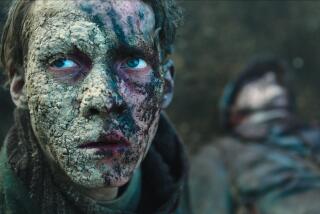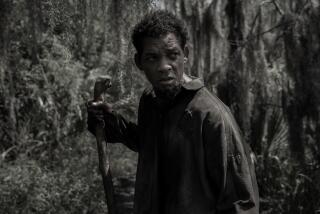SWAMPED IN ‘ANDERSONVILLE’
TURIN, GA. — Hundreds of men slog through ankle-deep mud, dodging ramshackle lean-to tents built close to the ground. Their clothes are little more than scraps and rags, their bodies encrusted with filth. Harsh smoke from hundreds of campfires stings their eyes and makes breathing difficult. Everywhere they turn, the horizon is cut off by enormous walls, 30 feet high, made of fresh-cut timber.
On 10 acres of a cattle farm in rural Georgia, Ted Turner has built his own little private hell--the set of “Andersonville.” The four-hour movie, airing Sunday and Monday on TNT, re-creates the infamous Confederate prison camp with an accuracy that, at least on the set, you can even smell.
The real Andersonville (now a national park in Georgia) was home in 1864 and 1865 to 45,000 Union prisoners, more than 13,000 of whom died, mostly from disease, malnutrition and exposure. The camp’s commandant, Capt. Henry Wirz, was the only soldier in the Civil War executed for war crimes.
“This is as close as America can come to ‘Schindler’s List,’ ” says Turner, who’s making a quick visit to the set with wife Jane Fonda.
While Fonda reminisces with director John Frankenheimer about common industry friends, Turner reviews the troops. “Hey, Jarrod,” he calls out to Jarrod Emick, Tony Award-winning star of Broadway’s “Damn Yankees,” who stars in “Andersonville” along with Frederic Forrest, Justin Henry, William H. Macy and Jan Triska.
A few minutes later, Fonda runs into Forrest, full-bearded, splotched with stage blood and fake wounds, his tattered clothes almost falling off his body. “My God, what have they done to you?” she exclaims as he grins.
Finally it’s time for Turner, Fonda and entourage to leave and shooting to resume.
Frankenheimer, the 30-year film vet whose resume includes “The Manchurian Candidate,” “Birdman of Alcatraz” and 1994’s award-winning “The Burning Season” for HBO, is held in very healthy respect by the cast and crew. Just about everyone on the set sooner or later makes the analogy that shooting “Andersonville” is like fighting a war, and Frankenheimer is definitely the commander.
“Mr. Frankenheimer is like working for a great general. But I wouldn’t want to get on his bad side,” says Bill Sanderson (Larry from “Newhart”), just a few minutes before some hapless crew member does just that.
“What did I say?” Frankenheimer barks at an underling. “That’s not what I said! We’re shooting it over the shoulder!” An Australian bush hat is perched atop his head, and even though he wears blue rubber waders over his lower legs, he has mud stains on his knees.
“I’m sure glad it’s not my first movie,” Frankenheimer says during the lunch break. “There’s no easy part. Every shot requires hundreds of extras, and you’ve always got this vast background. It’s hard not to get swamped in the vastness, to get the personal stories.”
Those stories, woven into one narrative, were written by David Rintels (“Day One”) and based on his own research of original diaries and accounts, rather than on MacKinlay Kantor’s 1955 Pultizer Prize-winning novel, which Hollywood has repeatedly optioned but never made. In Rintels’ telling, Cpl. Josiah Day (Emick) watches as a gang of renegade Union soldiers within the prison camp intimidates and murders other prisoners for their food, then is overpowered and tried by a court of the prisoners themselves.
“I wanted viewers to be able to watch this and not be able to tell if it was written by a Northerner or Southerner,” says Rintels (who’s from Massachusetts).
“This is a story about the grunts, about horrible conditions and how to survive them,” says Dale Fetzer, who choreographs the movements of the hundreds of bedraggled extras and Civil War re-enactors.
And although “Andersonville” will be known as Frankenheimer’s movie, it’s also a movie that belongs to those extras, the ones who stood in the rain, baby oil smeared in their hair to make it look greasy, mud and dirt caked on bare feet, marching back and forth inside the stockade, Ted Turner’s little hell on earth.
“Andersonville” airs Sunday and Monday at 5, 7 and 9 p.m. on TNT.
More to Read
Sign up for The Wild
We’ll help you find the best places to hike, bike and run, as well as the perfect silent spots for meditation and yoga.
You may occasionally receive promotional content from the Los Angeles Times.






